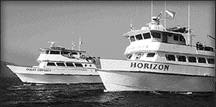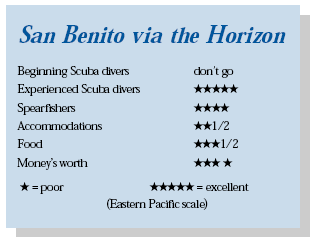From San Diego to San Benito, MexicoContents of this Issue: From San Diego to San Benito, Mexico Blast fishing: Slim pickings, yet major damage Marine Parks, Arrogant Management, Seven-Mile Beach Dump Valve Danger in AERIS, Sherwood and Genesis BCDs The Truth About Dive Releases, Part II Diversí 25-Hour Left at Sea Case Resolved Editorial Office: Ben Davison Publisher and Editor Undercurrent 3020 Bridgeway, Suite 102 Sausalito, CA 94965 Spearfishing and scuba aboard the Horizon from the April, 2001 issue of Undercurrent
Dear Fellow Diver: Iíd spent nearly three and a half hours floating on the surface with a cocked spear gun, waiting for a worthy target. Occasionally Iíd drop down to hunt, but nothing had caught my fancy. For the most part, Iíd watch the tens of thousands shimmering baitfish, swimming at random, feeding on plankton. At times, they would quickly ball up, sensing danger, then, they would slide in one direction and Iíd look the other way to watch the hunters arrive. Sometimes it was sea lions. Occasionally schools of 30 or more barracuda came to hunt. Several times I dropped down to be surrounded by hundreds of eight- to ten-pound yellowtails. I still waited. The water was chilly, even in August. I needed a full 7mm wetsuit to keep me warm on the 68-degree surface. Below, Iíd frequently hit a thermocline, where the water dropped below 60. The visibility ranged from a murky 15 feet to 70 feet, which is where it was today. The trick is to drop down and wait. I donít use a flotation device. I weight myself to be neutrally buoyant at 20 feet, so I become negative as I go deeper, making the descent effortless. If I were to get into trouble, Iíd drop my weight belt and my buoyancy would carry me to the surface. The goal is to relax, rid oneself of anxiety, make no unnecessary movement, conserve every molecule of air. The experts stay down a couple of minutes. As a scuba diver who does ab diving, I could last 45 seconds, getting as deep as 50 feet, with the aid of my long Cressi fins. There again a bait ball formed. I kicked down among
several small yellowtails. Out of the corner of my eye, I
saw a larger shape, perhaps a small seal, but no, this time a plump yellow tail, several times the size
of others. Now, before you cast aspersions on spear fishing, let me have a word with you.
First, please recognize this is about spearing food fish; not elegant angelfish or
beautiful triggerfish, or fish that hand feeding has tamed. This is about the fish
you order in restaurants or buy at the supermarket. Itís about the method of catching
fish for food. Itís not about spearing fish for contests, piling them up in
front for photos and leaving them to rot in the sun. Itís not about net fishing,
where for every food fish taken, pounds of
bycatch, are thrown overboard, dead. The demand
for the firm white flesh of the halibut results in
a bycatch of sea birds and sea otters. Still, you donít have to be a spearfisher to enjoy the waters of San Benito Island, 280 miles south of San Diego, and 50 miles off Mexicoís Baja Coast. Of the 20 passengers aboard the Horizon, seven were scuba-only divers, here to see the maelstrom of life where the cold pacific waters are pushed up the ridges to meet with the southern sun. Life flourishes, as it once did off Californiaís islands many years ago. Here, plankton to predators thrive. Guadeloupe fur seals constantly greeted me to dive, roll, blow bubbles with and make it painfully obvious how well suited they are for their environment. I had an advantage over scuba divers, because the seals moved in closer and were less frenetic than with divers blowing exhaust. California sea lions and elephant seals share the island. Among the thick kelp beds, their stocks gently swaying in the surge, are brilliant orange Garibaldi, sheepshead, wrasse, grand daddy kelp bass, as well as colorful nudibranchs and flat worms. Kicking out of the sunlit kelp beds, I saw hordes of pelagic fish in blue water, attracted by schools of sardine and pacific mackerel. The life and death energy is storybook. The smaller fish hunting in packs, the lunkers hunting as singles and pairs, the sea lions hunting the bait fish as well as the pelagics. Though I saw not a shark, one can assume that each is hunter and hunted. The Horizon, which sails out of San Diego for these one-week summer trips, is 80-feet long with a 25-foot beam. This is no luxury craft, not an Aggressor nor a member of the Hughes fleet. Itís outfitted for divers who seek adventure, not indulgence. Cruising between nine to ten knots, the trip to the islands takes a full day, and two nights and a day and a half coming back. With fairly calm seas each way, the captain kept the boat at a comfortable angle to the seas. Two compressors on the upper deck made sunbathing a noisy event, but werenít a disturbance in the salon or cabins. Navy showers were the rule (turn off the water while you lather) in the two private showers and the single on the deck. There is a dryer for wet towels and clothing and wetsuits were dried overnight in the engine room. The heads were kept clean and well stocked. The awkward-positioned mirrors created a daily paranoia of dropping a contact lens into marine head. Eight staterooms on the sides of
the boat have two bunks, a dresser,
clothes hooks, and ample storage under the lower bunk. Outside the staterooms is a
cluster of public bunks. Double bunks are barely sufficient for two small people; on
my trip, no one shared a double. Each bunk has a good reading light. While they provide
sheets, blankets, and pillows, my sheets slipped right off the vinyl mattress.
A sleeping bag might have been more comfortable. The four dive crew served me well, running a safe and satisfying trip. They set up tanks and BCís for the duration. Filled to 3,300 PSI, the tanks were ready whenever a diver was. Fins, masks, and wetsuits were stored along the gunnels in gear bags or ice chests. One can enter the water with a giant stride through side gates or off the swim step with ladders to get on board. Three inflatables take divers to distant sites and when divers were in the water, there was always one boat in communication with the divemaster by radio. When a scuba diver surfaced, they dispatched the inflatable for pick up. Free divers raised their spearguns to beckon the inflatable, either for a move to another site or to hand over a fish. Each anchorage generally allowed a couple of options for diving, depending on the conditions and animals one wanted to see. Though some sites on open pinnacles had ripping currents, protected areas could easily be found for scuba divers and photographers. The depths for scuba were generally moderate, while spearfishers hunted the edges of the blue water, where the bottom may drop to miles below. Photography, especially wide angle, was terrific, with great shots in kelp with sea lions passing through sun drenched fronds, rocky cliffs with white water, schools of fish, etc. The curious and playful sea lions and fur seals provided endless opportunities for terrific portraits. An array of nudibranchs, and small jellyfish make for other interesting photos. While free diving, all my shots were with black and white film in available light, a long lost underwater technique back in vogue. The H o r i z o n is photographer-friendly; thereís a rinse tank only for cameras, an area outside for cameras ready to go and one inside for extra cameras, lenses, and camera bags. The first couple of dives there was some scorn directed by photographers toward the spearfishers and some rumblings from the scuba divers that the trip was focused on spearfishing. However, after some exploration and finding the clear water, everyone lightened up and some even gave spearfishing a try. Blue-water hunting requires a spear gun powerful enough to penetrate and hold a large fish at 20 feet. I use a Riffe Islander rigged with four 9/16í diameter rubber bands, generating 360 pounds of thrust. Connecting the spear to the gun is a stainless steel shotline that is also connected to a floating line attached to a float. After a large fish is hit, the shot line breaks away from the gun. As the fish runs, the diver can surface and fight the fish from the surface. A good sharp dagger, inserted into the brain, is ideal for the coup de grace. Some divers use larger guns, treating San Bent as a warm up for tuna and wahoo blue-water hunting later trips. Their guns can generate 600 pounds of thrust. A new spear fisher was not prepared for the kick when he fired his gun for the first time; he ended with a blow to his cheek. The recoil can shatter a mask, or break a nose. A good set of gloves protects against sharp fish spines and frays on the steel cable. Note: pneumatic spearguns are against the law in Mexico and one is forbidden from taking lobster or abalone. While I generally find scuba diving effortless, free diving is effortless in its ideal, but it is much more active than scuba. With hours in the water you can imagine what a hunger it kicks up. Breakfasts included eggs any style as well as omelets with a variety of ingredients, French toast, pancakes, cereal, coffee, juice, muffins, served with bacon, sausage, or ham. Before lunch and dinner we typically had hamachi (raw yellowtail with Japanese horseradish and soy sauce) for an appetizer. Other times it was ceviche Mexican or Australian style (seven parts white vinegar, one part olive oil, onions, capers, salt and pepper), even seared ahi might appear. This was followed by a variety of hearty meals comprising fish, beef and chicken, usually grilled on a Weber. Lunch varied from hot-cooked meals to cold-cut sandwiches, along with hot soup. Portions were ample but not extravagant. The in-between-dive snacks were sparse. After diving was done beer was available for $2-$3.50 a bottle. Coffee, bottled water and soda were on the house. A couple of the crew had side businesses going; Mark served up rum and tequila and sold premium coffee at 75 cents/cup. Wine was available but many brought their own favorite. I spent the evenings telling lies to my companions, watching videos, playing cards, or watching the moon. There is no stereotype for spearfishers: they are men and women, ranging in ages from 20-60. Some were novice, others very experienced, with two-minute bottom time not unusual. One fellow with long scruffy hair, rolled up in kelp like an otter; it was a kick watching baby fur seals looking to suckle. Another lost his spear tip in 100 feet of water and free dived until he found it. I watched him on an evening dive go poke around at 50 feet, where on one breath he saw lobster, a horned shark and a ray. Another, a retired dentist, was often in the galley with needle and thread, magnifiers on, stitching up someoneís sliced finger or punctured calf -- his precise needlework always closed the wound. Sharp knives, spear points honed to a needle point, fish hooks, etc., give him plenty of work. When done, he dropped off to dives to 60 feet to nail a white Seabass, a wily adversary. People tell stories of losing fish to sharks in the Socorro islands. Or at nearby Guadeloupe Island, seeing big tuna, wahoo and the ultimate predator: White sharks. Testosterone and good-natured competition abound. Yet, if someone had a problem with gear, there was always several people ready to help. Experienced divers shared tips, tricks, and techniques. Between everyone, it was genuine goodwill. Of course, on such a long trip thereís a lot of transit time, which you can pass fishing (you need a rod with a 6/0 reel with 50-pound test, a few live-bait hooks in sizes 2 and 1, a few Salas type jigs). The tackle shops at the landing can help you out. You might be able to borrow a rod from someone on board, as there are only five trolling spots, which rotate when a fish is caught. Itís a fast troll at nine knots. Get lures that are designed for this speed. Jerry, the divemaster, the one who puts the trip together (through Marin Skin Diving in San Rafael, CA) is also a fine brewmaster who got the friendship rolling by bringing along a few kegs of his favorite beer and a keg of root beer. There is nothing like the open ocean, calm seas, cold beer, and the frenzy of a wild bite on tuna to start the stories rolling. So, getting a bit bored with tame fish, group dives, and the same old, same old? Get the adrenaline flowing by leaving the tanks behind and heading out on the Horizon, where you can be a hunter and perhaps even hunted. -- P.I. |

I want to get all the stories! Tell me how I can become an Undercurrent Online Member and get online access to all the articles of Undercurrent as well as thousands of first hand reports on dive operations world-wide
| Home | Online Members Area | My Account |
Login
|
Join
|
| Travel Index |
Dive Resort & Liveaboard Reviews
|
Featured Reports
|
Recent
Issues
|
Back Issues
|
|
Dive Gear
Index
|
Health/Safety Index
|
Environment & Misc.
Index
|
Seasonal Planner
|
Blogs
|
Free Articles
|
Book Picks
|
News
|
|
Special Offers
|
RSS
|
FAQ
|
About Us
|
Contact Us
|
Links
|
3020 Bridgeway, Ste 102, Sausalito, Ca 94965
All rights reserved.

 Stay cool, let the fish come to
you, donít make a futile effort chasing it.
Still, I became anxious, excited, and kicked
once, twice and again, directly at the fish,
my arm extending the gun, my left hand on
the butt, so the recoil wouldnít crush my
mask. Intent on feeding, the yellow tail
ignored my advance. I pulled the trigger
and instantaneously my spear pierced the
fish behind its gills. Whoa, the shot line
became entangled in the rubber bands that
power the six-foot shaft. I had to fight my
fish with only 20 feet of line and did he
take me on a ride, in fact several rides to
the bottom. Several times I kicked to the
surface for a gulp of air only to be dragged down again. Once at the surface I
waved wildly for the boat crew. In moments the inflatable arrived and Ron, the captain
helped me untangle the line. Finally, I was able to fight my fish from the
surface. Gradually, I brought in my fish. When I slid my hand into the gills, the
fish was mine. Thirty-seven pounds of yellowtail, destined for sushi and barbecue.
Stay cool, let the fish come to
you, donít make a futile effort chasing it.
Still, I became anxious, excited, and kicked
once, twice and again, directly at the fish,
my arm extending the gun, my left hand on
the butt, so the recoil wouldnít crush my
mask. Intent on feeding, the yellow tail
ignored my advance. I pulled the trigger
and instantaneously my spear pierced the
fish behind its gills. Whoa, the shot line
became entangled in the rubber bands that
power the six-foot shaft. I had to fight my
fish with only 20 feet of line and did he
take me on a ride, in fact several rides to
the bottom. Several times I kicked to the
surface for a gulp of air only to be dragged down again. Once at the surface I
waved wildly for the boat crew. In moments the inflatable arrived and Ron, the captain
helped me untangle the line. Finally, I was able to fight my fish from the
surface. Gradually, I brought in my fish. When I slid my hand into the gills, the
fish was mine. Thirty-seven pounds of yellowtail, destined for sushi and barbecue. Dolphins,
sea lions and even whales get hung up in fishing
nets, so we can feast on mahi-mahi or snapper.
Itís not about longline fishing, where you donít
know what ends up on a hook. The Hawaiian longline
industry, filling the demand created by fine
restaurants and sushi bars for ahi, inadvertently
hook as many as 100,000 sharks a year, and a
countless number of turtles, most of which are
thrown back dead. Spearfishing is about singling
out a specific fish that can feed a family. While
the oceans are being raped, spearing is the least
intrusive fishing method of all. Unlike a bear or
deer shot in the wild by a hunter, if the fish doesnít die on the end of a spear,
it may very well end up on someoneís plate, thanks to other fishing techniques. Even
commercial pen-raised salmon creates problems, as they pollute the waters theyíre
raised in and, when they escape, ruin the gene pool of wild salmon.
Dolphins,
sea lions and even whales get hung up in fishing
nets, so we can feast on mahi-mahi or snapper.
Itís not about longline fishing, where you donít
know what ends up on a hook. The Hawaiian longline
industry, filling the demand created by fine
restaurants and sushi bars for ahi, inadvertently
hook as many as 100,000 sharks a year, and a
countless number of turtles, most of which are
thrown back dead. Spearfishing is about singling
out a specific fish that can feed a family. While
the oceans are being raped, spearing is the least
intrusive fishing method of all. Unlike a bear or
deer shot in the wild by a hunter, if the fish doesnít die on the end of a spear,
it may very well end up on someoneís plate, thanks to other fishing techniques. Even
commercial pen-raised salmon creates problems, as they pollute the waters theyíre
raised in and, when they escape, ruin the gene pool of wild salmon. The engines are audible during
transit, but I slept well, especially since air conditioning kept belowdecks comfortable. At St. Benito (which regulars
call St. ďBentĒ) the boat moved during
the hours most people were awake. The
back deck had plenty of room for suiting
up, however if everyone were on scuba it
would get crowded. And if the boat had a
full complement of 32, it would be a
mess, from bow to stern.
The engines are audible during
transit, but I slept well, especially since air conditioning kept belowdecks comfortable. At St. Benito (which regulars
call St. ďBentĒ) the boat moved during
the hours most people were awake. The
back deck had plenty of room for suiting
up, however if everyone were on scuba it
would get crowded. And if the boat had a
full complement of 32, it would be a
mess, from bow to stern. Divers Compass: The Horizon runs trips to Mexicoís Islands from June
to November. For seven days figure $150/days; because of reduced passengers,
our trip was $1,400. The Horizon offers 1-3 to California
destinations for $100-$120/day (food included)... The 10 trips to
Mexico this summer have been chartered by various groups, including
dive stores; call 858-277-7823 or go to
Divers Compass: The Horizon runs trips to Mexicoís Islands from June
to November. For seven days figure $150/days; because of reduced passengers,
our trip was $1,400. The Horizon offers 1-3 to California
destinations for $100-$120/day (food included)... The 10 trips to
Mexico this summer have been chartered by various groups, including
dive stores; call 858-277-7823 or go to 